Abstract
This study aims to comprehensively analyze the stability of rock mass around the gob side driving roadway in a significant inclined mining face. By considering the geological parameters and engineering conditions of specific cases, we carefully explored many factors affecting the stability of the surrounding rock mass, such as the mechanical properties of rocks, formation inclination, and the existence of goaf. Based on this, we construct a numerical model for analyzing the stability of the rock mass around the gob side driving roadway. Subsequently, we made a detailed investigation of the stress distribution and the characteristics of the plastic zone. In addition, through the analysis of the destruction mode and stress distribution characteristics of the rock mass, we establish the appropriate width of the coal pillar and thus provide a scientific basis for the formulation of support countermeasures; finally, the support countermeasures proposed in this study have achieved remarkable results in practical application and verify the feasibility and practicability of the research method. This support scheme ensures the stability of the gob side entry over its service life. It is hoped that this scheme can be promoted in similar projects to help maintain mine safety.
1. Introduction
The challenging issue of surrounding rock control in deep roadways mostly arises from the increasingly complicated environment associated with greater mining depth [1,2]. The most prevalent factors include elevated ground stress, extreme temperatures, significant karst water pressure, and intense mining disturbance. This problem poses significant hurdles to the advancement of roadside support technology.
During the excavation and extraction process, the distribution of advance abutment pressure varies. Engineering geological constraints led Zha and Shi [3] to reject feasible supporting systems for the gob side entrance at an isolated island coal face. Bai and Shen [4] formulated a mechanical model illustrating the dynamic process of roof deformation and computed the principal technical parameters in gob side entry driving. Y. Zhang [5] validated the gob side entry deformation method and introduced coupling control technology. Y. Jiang [6] examined the areas of maximum roadway roof deformation in an island mining panel. S. Zhang [7] established coal pillar width through the analysis of lateral support stress distribution and rock deformation. Fan and Wang [8] demonstrate that deep roadways are susceptible to significant deformation due to elevated stress, complicating management efforts. Zang and Chen [9] build a numerical model in UDEC to examine the failure characteristics and support scheme of haulage roadways. Liu and Han [10] investigated the deformation features of adjacent rock and the behavior of strata during gob side entry. J. Yang [11] demonstrated an asymmetric control technique to ensure roadway safety, grounded in the caving motion law of overlaying strata in island coal faces. B. Jiang [12] devised an integrated early warning system for rock burst occurrences in island coal faces. Qian [13] observed that stability control methods and reduced coal pillar width influence rock deformation. He and Sun [14] investigated the flexibility of light-powered support at the top-coal caving face by the analysis of systematic monitoring data. Zhu [15] examined the elastic strain energy released from roof fracture, the distribution of seismic events, and fault displacement.
In coal mining with significant dip, Ye and Wang [16] utilized a physical model to examine the characteristics of crack evolution. Numerical simulation methodologies have been utilized to analyze the migration of mining pressure in steep dip stopes [17,18,19]. The results indicate that the tension on the bottom of the gob is greater than that on the upper side. The advanced part of the gob side entry has a heightened propensity for rock bursts due to mining disturbances. Cheng et al. examined the deformation properties of gob side entries. Utilizing rock mechanical techniques [20,21], they examined the stress distribution in the gob side pillar or backfilling sidewall. Researchers have achieved advancements in the investigation of the failure mechanisms of pillars [22,23]. Tectonic stress significantly impacts mining projects. Sun [24] discovered that rock mechanics parameters influence the developing characteristics of tectonic cracks in sedimentary basins. Matsumoto [25] assessed the relative deviatoric stress field on Kyushu Island. Through the analysis of observed stress, pore pressure, and mechanical rock property data, Vo and Chang [26] conclude that exogenous tectonic forces are present. F. Zhang [27] conducted numerical simulations and geological analyses to ascertain the cause of overpressure in relation to mudstone and sandstone.
Selecting appropriate supporting parameters can more effectively meet the demands of surrounding rock stabilization in the vacant roadway. In an unoccupied roadway with specific conditions, if the surrounding rock stress is substantial and the coal rock is fractured, it is challenging to implement a singular bolt support system to satisfy the requirements for roadway maintenance. The integration of diverse assistance modalities should be contemplated at this juncture. S. Q. Yang [28] investigated the failure mechanisms and control technologies in deep-buried soft rock roadways. Utilizing a large-scale geomechanically model testing system, Li [29] evaluated the pressure relief and anchor support system. Xu and Wang [30] investigated the abutment pressure in front of the coal face within the isolated island mining zone, supplying data for roadway maintenance and dynamic disaster prediction. Batugin and Wang [31] examined the integrated support mechanism and its stress field resulting from mining activities, thereby confirming the specifications of bolts and anchor cables. E. Wang [32] introduced an asymmetric composite support framework for coal pillars in challenging geological conditions. Yuan and Wang [33] examined the support mechanism of a haulage roadway at the −850 m mining level.
The current stability research of the aerial roadway mostly relies on theoretical analysis, numerical modeling, and other methodologies, encompassing the lateral support pressure at the mining face and the plastic zone of the coal pillar. The collaborative support of the surrounding rock and its inherent load-bearing capabilities have gradually been taken into account. The focus of surrounding rock control in the excavated roadway pertains to the deformation of the surrounding rock, utilizing high-strength support and grouting techniques to enhance stability. Currently, there is limited research examining the collaborative support of alleyways in deep mining. In inclined mining, scientists primarily concentrate on examining the motion dynamics of the roof strata. We must enhance efforts in the advancement of damage mechanisms and control technologies along the roadway. Studying the width of coal pillars is crucial for accommodating varying geological conditions and optimizing the mining strategy. We investigate the stress distribution and plastic zone characteristics to understand the rock mass destruction patterns and stress distribution characteristics. The elements influencing stability along the roadway and evaluating the deformation features of the roadway will be examined through numerical modeling. Recommendations for roadway support will be presented based on the research findings.
2. Materials and Methods
We take an inclined coal stope to analyze the support process along the gob side entry. This case has several features, including large burial depth, large inclination angle, narrow coal pillar, and faults.
2.1. Brief of the Case
The research subject is the 3308 track entry from Yangcheng Coal Mine at Jining, Shandong Province. The layout of researched mining face is shown in Figure 1. The 3308 mining face is situated deep within the third mining area and is next to the 3306 goaf. The mean thickness of coal is 7.5 m. The mining face inclination ranges from 23° to 27°, with an average of 25°. The coal seam is directly overlain by siltstone with a thickness of 3.8 m. The upper layer consists of fine sandstone, about 17.1 m in thickness. The pseudo-bottom consists of mudstone, with a thickness of 1.6 m. The coal and roof has a pronounced impact tendency. The floor shows a modest impact tendency. During construction, minor impact phenomena from the coal cannon may arise. The 3306 belt entry is positioned within coal and is excavated along the floor. The roadway has a rectangular cross-section, and the excavation dimensions are 5.0 × 3.4 m.

Figure 1.
Layout of 3308 mining face (unit: m).
The 3308 track entry is subjected to severe stress, resulting in the deterioration of surrounding rock. Four elements are outlined based on the evaluation results of geomechanical properties. By considering the geological parameters and engineering conditions, the stability of the rock mass around the gob side driving roadway in the significantly inclined mining face is comprehensively analyzed.
- (1)
- Buried Depth
The mining face elevation is −780~−960 m, and the ground elevation −35.9~+38.9 m. The coal mine is located in a plain area, with the flat surface of villages and farmland. The maximum buried depth of the mining face is close to 1000 m. The most important feature of deep mining is high stress, which further contributes to nonlinear stress characteristics of rock. The buried depth condition leads to the enhanced effect of surrounding rock disturbance and the increased difficulty of control.
- (2)
- Strata Thickness and Lithology
The average thickness of coal is 7.5 m. The mining face is made of fully mechanized discharge mining. The roof movement in the process of extraction is relatively strong. The main roof is a fine sandstone of 17.1 m thick. After the mining of the 3306 face, the thick and hard roof forms a cantilever beam structure at the lateral boundary of the goaf, which provides certain cover for the excavation of the 3308 track entry. However, during the mining period of the 3308 face, the sandstone roof is not easy to break, causing high pressure at the lateral boundary. The immediate floor is mudstone, 1.6 m thick. The floor strength is low, leading to a large deformation tendency. The burial depth and lithology conditions of the engineering case show that the mine pressure is strong during the extraction process.
- (3)
- Geological Structure and Tectonic Stress
The mining region is intersected by several faults, and coal extraction is influenced by intricate geological formations. The stress within the fault structure is concentrated, and the stress environment of the adjacent rock is intricate.
- (4)
- Stratigraphic Dip
The mean formation inclination is 25°. The mining face 3308 is situated beneath the 3306 goaf in the inclined direction. Subsequent to the coal seam at the 3306 mining face, the roof has a tendency to subside and shift towards the goaf. At significant inclination degrees, the coal pillar experiences compression and shear forces. The stress distribution of the pillar is intricate. The force of surrounding rock is uneven. If the conventional symmetry anchor network support technology and process are adopted, the stability of the roadway cannot be effectively controlled.
2.2. In Situ Stress Measurement
In situ stress is a contributing factor to the deformation of surrounding rock during roadway excavation. Understanding the ground stress distribution pattern of the mining region is essential to accurately estimate the roadway configuration and support system. The hollow cylinder stress relief method was used. This method is a three-dimensional ground stress test method. The equipment is relatively simple to operat and has an advantage of timesaving. This method will not change and damage the stress state of the original rock, and can objectively reflect the internal stress state of the rock mass. Select rock mass for testing, and stay away from fault and goaf. Keep away from the roadway and the stress concentration area, and avoid it. Stay free from unstable areas and interference sources, like landform and saturated strata. It can measure the size and direction of all stress components, with high accuracy and reliability. The locations of measurement stations are established by integrating the roadway configuration of Yangcheng Coal Mine, as illustrated in Table 1.

Table 1.
Drilling parameters of in situ stress measurement.
2.3. Numerical Simulation
Numerical simulation is utilized to assess the stress and deformation characteristics of the support system. The initial design of coal pillar are 3 m, 4 m, 5 m, and 6 m in width. The stability of the roadway will be quantitatively assessed using Flac3D to ascertain the optimal pillar width. Flac3D Version 6.0 is a three-dimensional numerical simulation software, suitable for the analysis of the mechanical behavior of rocks and structures. It is based on the finite difference method and is suitable to simulate the stress and deformation of complex geological bodies. The Flac3D is particularly suitable for the analysis of surrounding rock stability and supporting structure. The size of this model is 708,060 m, as shown in Figure 2. The numerical model consists of 138,710 grid points, 799,586 zones, and 28 zone groups. The grid near the roadway and the coal post was 0.4 m. The size of the model boundary grid was 2.0 m. The model top was subjected to a gravitational load of 22 MPa, with fixed normal displacement at other boundaries. The studied roadway was close to the ground stress measurement point of #3, so the initial ground stress was set according to its value. Three main stress vectors are included in the stress solution calculation results. During the numerical simulation process, the numerical value and direction of the maximum, intermediate, or minimum stress was separately set by the “zone initialize stress-principle” keyword.
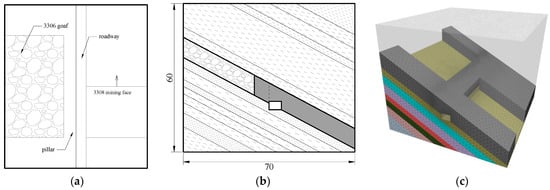
Figure 2.
Numerical model. (a) Top view. (b) Front view. (c) Perspective view.
In the roadway support simulation, the Mohr–Coulomb criterion can be used to analyze the stress mechanism of supporting structures such as anchors and shotcrete. The M-C criterion has the advantages of a strong foundation and easily accessible parameters in the roadway stability simulation. One can conduct a sensitivity analysis by adjusting cohesion and friction to assess their effects on the extent of the plastic zone and the supporting effect. By adjusting the length, diameter, row distance, and other parameters of the bolt, the control function of the roof and roadway deformation is quantitatively evaluated so as to provide data support for the support design. As illustrated in Figure 3, from point A to B,
and from B to C by a tension failure,
where σ1 and σ3 are the maximum and minimum principle stresses, respectively, MPa; σt is the tensile strength, MPa; c is cohesion, MPa; and ϕ is friction, °.
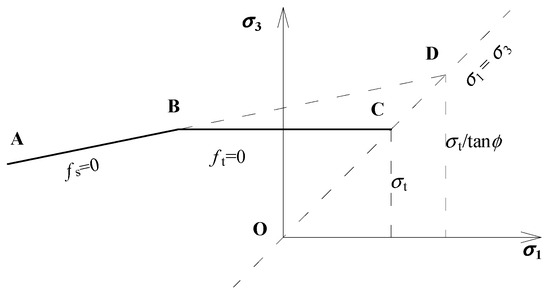
Figure 3.
M-C yield criterion.
The rock mechanical parameters are shown in Table 2.

Table 2.
Mechanical parameters of the rock.
2.4. Roadway Displacement Measurement
The optimal control scheme is undergoing industrial testing in the 3308 track entry. Incorporate the viability and reliability using the field monitoring data validation mechanism. Figure 4 illustrates the arrangement of four displacement measuring stations positioned at 50 m intervals along the 3308 track entry. Devices #1 and #2 monitor the displacement of the roadway surface, while devices #3 and #4 measure the interior displacement of the surrounding rock.

Figure 4.
Layout of monitoring sections.
3. Results
3.1. Geostress
The geostress components are shown in Table 3. The elevation of measurement locations #1 and #2 are both −650 m, with maximum principle stresses σ1 of 21.3 MPa and 20.2 MPa, respectively, resulting in an average of 20.75 MPa. The significant disparity between the σ1 and the vertical stresses σv reveals the predominance of horizontal stresses in the mine.

Table 3.
Components of in situ tress.
The is direction of the σ1 at measurement points #1 and #2 approximately 120°, with a dip angle of 5 to 10°. The σ1 values range from 20 to 22 MPa, exceeding the σv. The direction angle of the minimal principal stress σ3 ranges from 210° to 215°, the dip angle is around 13°, and the stress magnitude varies within 10 MPa. The disparity between the σ1 and σ3 is significant, with Δσ measuring 13.4 MPa and 10.2 MPa, respectively, whereas the σ1/σ3 are 2.0 and 2.7. The significant disparity in stress alterations will result in substantial deformation of the surrounding rock. The angle between the intermediate principal stress σ2 and the horizontal plane is predominantly around 75°, with the stress magnitude ranging from 12.4 to 14.7 MPa.
The measurement location at the elevation of −920 m yields a bigger value, with the direction of σ1 recorded at 161.4°. The value of σ1 is 35 MPa, and the σ3 is 19.7 MPa, resulting in a difference of 15.3 MPa and a ratio of 1.78. The maximal primary stress is oriented horizontally, with a magnitude about 1.3 to 1.52 times the gravity load, considerably affecting the mining configuration.
3.2. Coal Pillar Width Analysis
The 3308 track entry is adjacent to the 3306 goaf. The width of the coal pillar directly affects the stress distribution and deformation characteristics of the surrounding rock. Analyzing the appropriate coal pillar width can not only improve the recovery rate, but also reduce the risk of rock burst. By analyzing the destruction mode of surrounding rock, the support countermeasure of roadway could be proposed.
- (1)
- Vertical Stress
Figure 5 illustrates the vertical stress distribution of the surrounding rock with varying coal pillar widths. The stress concentration zone occurs when the contour surpasses 22 MPa. Three regions of stress concentration are indicated, with the stress maxima in each region illustrated in Figure 6. Regions #1 and #2 are situated in the upper and lower sections of the coal pillar, influencing its stability. When the pillar’s width is 3 m, the range and peak stress in the two concentrated places are minimal; there exists a pressure relief zone within the pillar, where the stress value is below 22 MPa. As the width of the coal increases, the range and stress values of regions #1 and #2 also rise. When the breadth attains 4 m, the stress value in the center of the coal pillar hits 22 MPa. When the breadth attains 5 m, the two stress concentration zones in the coal pillar become interconnected, which compromises safety. The stress of the coal pillar suggest optimal widths of 3 m and 4 m.
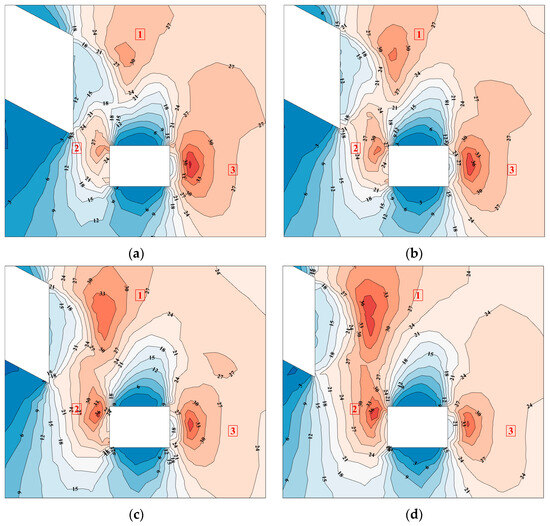
Figure 5.
Surrounding rock stress: (a) 3 m; (b) 4 m; (c) 5 m; (d) 6 m.
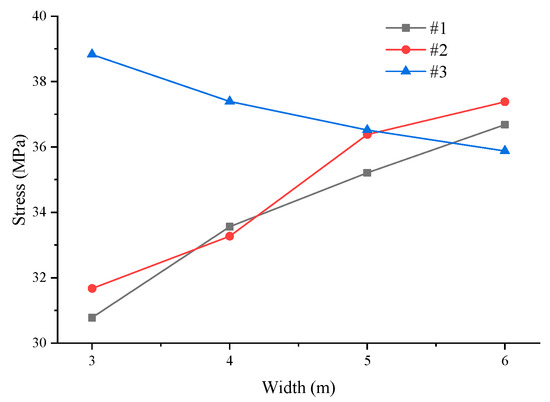
Figure 6.
Stress peak vs. coal pillar width.
- (2)
- Plasticity State
The distribution characteristics of the plastic regions are shown in Figure 7. According to the destruction criteria, after the yield, the force state is located outside the M-C envelope. The plastic zone shows a combination of yield form and yield state. Where “shear” and “tension” are t yield forms, “n” is the critical yield state and “p” means already yielded. The types of plastic zones are distinguished by different colors. Marked in green, the plasticity state of the coal pillar is the combination of “shear-n” and “shear-p”. With the increase in width, the color in the coal pillar gradually changes from green to cyan (only “shear-p”). This phenomenon shows that the pressure of the coal pillar is positively correlated with the width. In other words, the larger pillar width can easily cause destruction and even the collapse of the pillar. The characteristics of the plastic zone indicate that a smaller width should be selected.
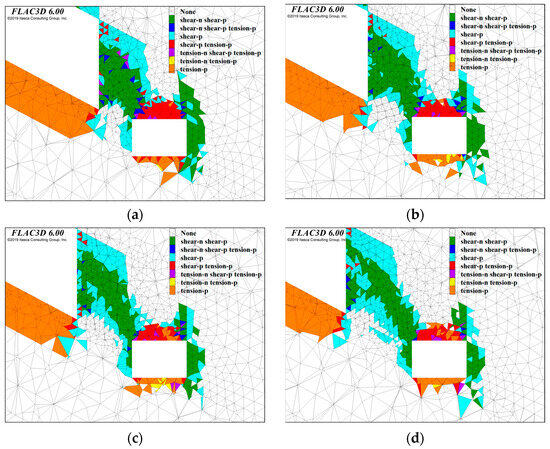
Figure 7.
Plasticity state: (a) 3 m; (b) 4 m; (c) 5 m; (d) 6 mm.
Marked in red, the plasticity state of roadway roof is the combination of “tension-p” and “shear-p”. This phenomenon indicates that the stability of the roadway roof is worse than that of the coal pillar. Figure 8 shows the statistical results of the plastic area of the roadway roof. The area marked red is 10.88 m2 when the pillar is 3 m. Shear and tensile yield occur at the roadway roof and floor. This phenomenon shows that the coal pillar width is small, and its bearing capacity is insufficient to maintain the stability of the roadway. When the width of the coal pillar is not less than 4 m, the area of the red zone decreases. The characteristics of plasticity state indicate that the suiTab.coal pillar width is 4 m, 5 m, and 6 m. Combining the stress and plastic zone characteristics of the surrounding rock, the optimal coal pillar width is 4 m.
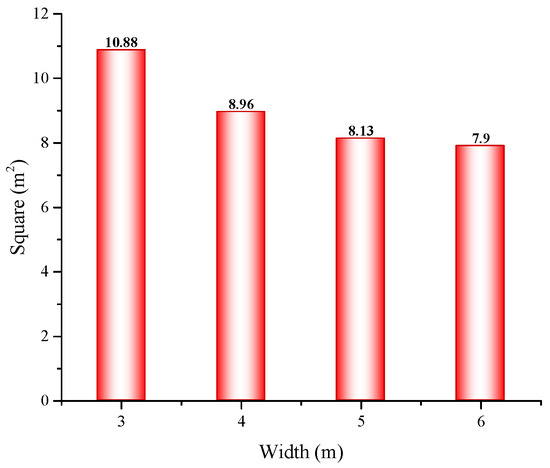
Figure 8.
Square of roof failure vs. pillar width.
3.3. Support Scheme
All the supporting components are from Shiheng Special Steel Group Co., Ltd., Feicheng (271612), Shandong Province, Chana. Anchor net cable beam is used for combined support, and the parameters are shown in Figure 9.
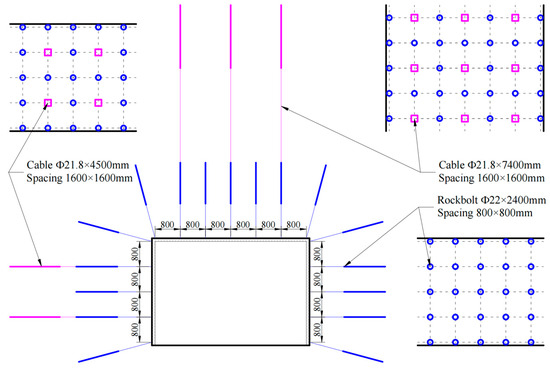
Figure 9.
Roadway support parameters (unit: mm).
- (1)
- Rock Bolt
Utilizing Φ 22 × 2400 mm high-stiffness prestressed left-handed threaded rock bolt, seven bolts per row and equipped with a relief ring. The interrow spacing measures 800 × 800 mm. The bolt employs one MSK2550 and one MSCK2535 resin anchor agent, measuring 1270 mm in grouting length. The anchor force must be no less than 50 kN.
- (2)
- Anchor Cable
In Flac3D, the support is simulated by adding structural units. The cable is a linear structural unit. By assigning different parameters to each segment, the simulation of the anchor end and the free segment is realized. The specification of the roof anchor cable is Φ 21.8 × 7400 mm; the specification of the coal pillar anchor cable is Φ 21.8 × 4500 mm. The spacing between the anchor cables is 1600 mm. Each anchor cable is secured with two MSK2550 and one MSCK2535 resin anchor agent, each measuring 2030 mm in grouting length. The anchorage force of the anchor cable is no less than 150 kN. The anchor cable is compatible with the flat tray, with dimensions 300 × 300 × 16 mm.
- (3)
- Steel Mesh
The metal mesh is made of Φ 5.5 mm cold-drawn steel bar. The mesh size is 100 × 100 mm. Use 14 # iron wire to connect the protective mesh, and the lap size is 200 mm.
3.4. Support Effect
Analyze the stability of the surrounding rock by considering the roadway located 10 m ahead of the mining face. The distribution characteristics of displacement and plastic zones within the roadway are illustrated in Figure 10. Anchor cables are secured in the stable strata. The maximum displacement of the roadway roof measures 103 mm; compare with the left side displacing 30 mm and the right side 70 mm. The depth of the roof’s tensile plastic zone is approximately 800 mm. The plastic area of the left side is smaller than that of the right. The findings indicate that the implementation of anchor cable support effectively mitigates the deformation of the surrounding rock.
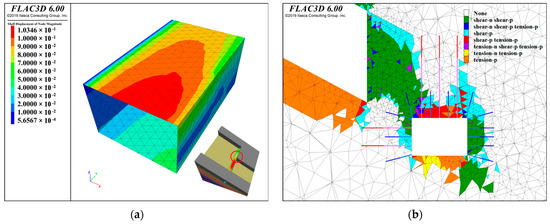
Figure 10.
Roadway deformation analysis. (a) Displacement; (b) plasticity state.
The deformation of the surrounding rock in the roadway is shown in Figure 11. The data in the figures show the following:
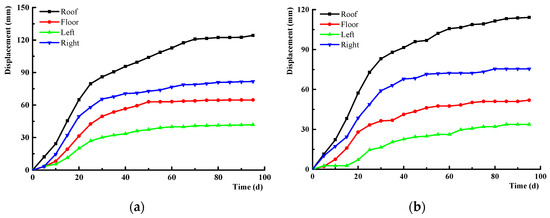
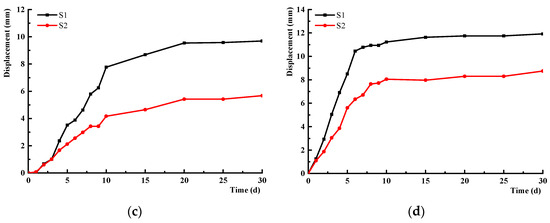
Figure 11.
Displacement monitoring result. (a) Section #1; (b) Section #2; (c) Section #3; (d) Section #4.
- (1)
- During the initial phase of 3308 track entry driving, the displacement variation is significant, exhibiting a rapid upward trajectory. The support resistance escalates with deformation. The roadway deformation stabilized after 70 days of support application, signifying that the surrounding rock stress attained equilibrium.
- (2)
- The change size of roadway displacement is as follows: roof > solid coal side > floor > pillar side. Subsequent to the stabilization of the surrounding rock deformation, the roof subsidence measures 120~130 mm. The floor heave measures 50~60 mm. The lateral displacement of the solid coal is approximately 70~80 mm. The pillar displacement measures 30~40 mm. The deformation of the two sections is asymmetric, although the displacement remains within the acceptable limit.
- (3)
- Following the excavation of the roadway, the stability of the roof is augmented. Ten days prior to the roadway excavation, the expansion rate of the separation layers is considerably high. As monitoring time increases, the internal deformation rate of the surrounding rock progressively diminishes. The roof crack’s maximum width is around 12 mm. The monitoring results indicate that the support strategy can significantly diminish layer separation.
4. Discussion
The stress state of the surrounding rock along the gob side entry are asymmetric, with the roadway roof and coal pillar identified as critical failure zones. Based on the deformation properties of deep surrounding rock, bolt and cable support is sufficient to enhance the bearing capacity of the surrounding rock. Strengthening the critical zones with substantial force, thereby enhancing its shear and slip resistance. The high stiffness anchor cable is employed to secure the surrounding rock of the roadway within the stable rock mass, so ensuring the overall stability of the roadway.
- (1)
- High-Stiffness Rock Bolt
To prevent the surrounding rock in the anchorage region from developing a detached layer, the applied cable force must attain 30~50% of the rock mass’s yield strength. The high-stiffness rock bolt is employed to create a compressive stress zone in the shallow surrounding rock via the pretensioning force, thereby mitigating the formation of fractures. The pallet and steel belt will effectively distribute the prestress, enhancing total support strength and stiffness.
- (2)
- Anchor Cable
Long anchor cable is employed to secure the deep layer of coal, thereby minimizing the degradation of the surrounding rock. Utilizing high-stiffness anchor cable to create an expanded bearing range.
- (3)
- Strengthen the Coal Pillar
Following roadway excavation, the coal pillar is susceptible to deformation due to excessive stress. The short anchor cable should be employed to reinforce the pillar, thereby extending the control range of the rock bolt and enhancing the strength of the gob side entry.
5. Conclusions
The 3308 track entry at Yangcheng Coal Mine serves as the project context. The mining depth, along with the significant inclination and thickness of the coal seam, results in a complex stress environment. The stability of surrounding rock is examined through numerical investigation. The conclusions are encapsulated as follows:
- (1)
- Analyzing the pillar width in the context of a significant inclination angle. When the breadth of the coal pillar ranges from 3~6 m, the surrounding rock pressure is consistently asymmetric. The pillar and roof possess the primary reinforcement zone for surrounding rock stabilization. The displacement of the roadway exhibits an asymmetric characteristic relative to the roof, solid coal side, and pillar side. The plastic zone consistently exhibited an unequal distribution in its width. A thorough assessment of stress and plastic area parameters indicates that the optimal coal pillar width is 4 m.
- (2)
- Proposing control measures for the gob side entry. The proposed essential technology for surrounding rock control is based on the features of stress and the plasticity state. Utilizing high-stiffness (500 MPa) rock bolt, the size is Φ 22 × 2400 mm and the spacing measures 800 × 800 mm. The stiffness of cable is 1860 MPa and the spacing measures 1600 × 1600 mm. The size of roof cable and pillar cable is Φ 21.8 × 7400 mm and Φ 21.8 × 4500 mm, respectively. After 70 days of support application, the maximum displacement is measured on roof, with a reasonable value of 130 mm.
Author Contributions
Conceptualization, Z.Q.; Data curation, N.L.; Investigation, F.Z.; Methodology, Y.L.; Resources, Z.Q.; Validation, F.Z. and N.L.; Visualization, Y.L.; Writing—original draft, Y.L. All authors have read and agreed to the published version of the manuscript.
Funding
This work is financially supported by the “Natural Science Foundation of Shandong Province, China” (Grant No. ZR2021ME248).
Institutional Review Board Statement
Not applicable.
Informed Consent Statement
Not applicable.
Data Availability Statement
All data generated or analyzed during this study are included in this article or available from the corresponding author upon reasonable request.
Acknowledgments
Yangcheng Coal Mine provides materials and places for the research, for which we express our gratitude.
Conflicts of Interest
There are no conflicts in the contribution, data, or achievement of the authors of this manuscript.
References
- Wang, Q.; Jiang, Z.; Jiang, B.; Gao, H.; Huang, Y.; Zhang, P. Research on an automatic roadway formation method in deep mining areas by roof cutting with high-strength bolt-grouting. Int. J. Rock Mech. Min. Sci. 2020, 128, 104264. [Google Scholar] [CrossRef]
- Ranjith, P.G.; Zhao, J.; Ju, M.; De Silva, R.V.S.; Rathnaweera, T.D.; Bandara, A.K.M.S. Opportunities and Challenges in Deep Mining: A Brief Review. Engineering 2017, 3, 546–551. [Google Scholar] [CrossRef]
- Zha, W.; Shi, H.; Liu, S.; Kang, C. Surrounding rock control of gob-side entry driving with narrow coal pillar and roadway side sealing technology in Yangliu Coal Mine. Int. J. Min. Sci. Technol. 2017, 27, 819–823. [Google Scholar] [CrossRef]
- Bai, J.-b.; Shen, W.-l.; Guo, G.-l.; Wang, X.-y.; Yu, Y. Roof Deformation, Failure Characteristics, and Preventive Techniques of Gob-Side Entry Driving Heading Adjacent to the Advancing Working Face. Rock Mech. Rock Eng. 2015, 48, 2447–2458. [Google Scholar] [CrossRef]
- Zhang, Y.; Xia, X.; Sun, X.-m.; Song, P.; Wang, J.; Sun, S.-j.; Chen, C. Research on Coupling Control Technology of Constant Resistance in Gob-side Entry Under Mined Gob of Recent Coal Seam Group. Geotech. Geol. Eng. 2020, 38, 4685–4699. [Google Scholar] [CrossRef]
- Jiang, Y.; Wang, H.; Xue, S.; Zhao, Y.; Zhu, J.; Pang, X. Assessment and mitigation of coal bump risk during extraction of an island longwall panel. Int. J. Coal Geol. 2012, 95, 20–33. [Google Scholar] [CrossRef]
- Zhang, S.; Wang, X.; Fan, G.; Zhang, D.; Jianbin, C. Pillar size optimization design of isolated island panel gob-side entry driving in deep inclined coal seam—Case study of Pingmei No. 6 coal seam. J. Geophys. Eng. 2018, 15, 816–828. [Google Scholar] [CrossRef]
- Fan, L.; Wang, W.; Yuan, C.; Peng, W. Research on large deformation mechanism of deep roadway with dynamic pressure. Energy Sci. Eng. 2020, 8, 3348–3364. [Google Scholar] [CrossRef]
- Zang, C.; Chen, M.; Zhang, G.; Wang, K.; Gu, D. Research on the failure process and stability control technology in a deep roadway: Numerical simulation and field test. Energy Sci. Eng. 2020, 8, 2297–2310. [Google Scholar] [CrossRef]
- Liu, F.; Han, Y.; Liu, J. Deformation Mechanism and Control of the Surrounding Rock during Gob-Side Entry Driving along Deeply Fully Mechanized Caving Island Working Face. Geofluids 2021, 5515052. [Google Scholar] [CrossRef]
- Yang, J.; Cao, S.; Li, X. Failure laws of narrow pillar and asymmetric control technique of gob-side entry driving in island coal face. Int. J. Min. Sci. Technol. 2013, 23, 267–272. [Google Scholar] [CrossRef]
- Jiang, B.; Wang, L.; Lu, Y.; Wang, C.; Ma, D. Combined early warning method for rockburst in a Deep Island, fully mechanized caving face. Arab. J. Geosci. 2016, 9, 743. [Google Scholar] [CrossRef]
- Qian, D.; Zhang, N.; Shimada, H.; Wang, C.; Sasaoka, T.; Zhang, N. Stability of goaf-side entry driving in 800-m-deep island longwall coal face in underground coal mine. Arab. J. Geosci. 2016, 9, 82. [Google Scholar] [CrossRef]
- He, H.; Sun, L.; Su, S.; Yang, B.; Yi, P. Study on Strata Behavior Law and Support Adaptability in Fault Island Pillar Light Caving Face. Procedia Earth Planet. Sci. 2011, 2, 40–43. [Google Scholar] [CrossRef]
- Zhu, G.-a.; Dou, L.-m.; Wang, C.-b.; Li, J.; Cai, W.; Ding, Z.-w. Numerical investigation of the evolution of overlying strata and distribution of static and dynamic loads in a deep island coal panel. Arab. J. Geosci. 2017, 10, 549. [Google Scholar] [CrossRef]
- Ye, Q.; Wang, G.; Jia, Z.; Zheng, C.; Wang, W. Similarity simulation of mining-crack-evolution characteristics of overburden strata in deep coal mining with large dip. J. Pet. Sci. Eng. 2018, 165, 477–487. [Google Scholar] [CrossRef]
- Liang, Z.; Song, W.; Liu, W. Theoretical models for simulating the failure range and stability of inclined floor strata induced by mining and hydraulic pressure. Int. J. Rock Mech. Min. Sci. 2020, 132, 104382. [Google Scholar] [CrossRef]
- Cheng, Q.; Shi, Y.; Zuo, L. Numerical Simulation and Analysis of Surface and Surrounding Rock Failure in Deep High-Dip Coal Seam Mining. Geotech. Geol. Eng. 2019, 37, 4285–4299. [Google Scholar] [CrossRef]
- Chi, X.; Yang, K.; Wei, Z. Breaking and mining-induced stress evolution of overlying strata in the working face of a steeply dipping coal seam. Int. J. Coal Sci. Technol. 2021, 8, 614–625. [Google Scholar] [CrossRef]
- Yang, Z.; Liu, C.; Tang, S.; Dou, L.; Cao, J. Rock burst mechanism analysis in an advanced segment of gob-side entry under different dip angles of the seam and prevention technology. Int. J. Min. Sci. Technol. 2018, 28, 891–899. [Google Scholar] [CrossRef]
- Chang, Q.; Tang, W.; Xu, Y.; Zhou, H. Research on the width of filling body in gob-side entry retaining with high-water materials. Int. J. Min. Sci. Technol. 2018, 28, 519–524. [Google Scholar] [CrossRef]
- Wu, W.-d.; Bai, J.-b.; Wang, X.-y.; Yan, S.; Wu, S.-x. Numerical Study of Failure Mechanisms and Control Techniques for a Gob-Side Yield Pillar in the Sijiazhuang Coal Mine, China. Rock Mech. Rock Eng. 2018, 52, 1231–1245. [Google Scholar] [CrossRef]
- Sun, Q.; Zhang, J.; Huang, Y.; Yin, W. Failure Mechanism and Deformation Characteristics of Gob-Side Entry Retaining in Solid Backfill Mining: A Case Study. Nat. Resour. Res. 2019, 29, 2513–2527. [Google Scholar] [CrossRef]
- Guo, P.; Ren, D.; Xue, Y. Simulation of multi-period tectonic stress fields and distribution prediction of tectonic fractures in tight gas reservoirs: A case study of the Tianhuan Depression in western Ordos Basin, China. Mar. Pet. Geol. 2019, 109, 530–546. [Google Scholar] [CrossRef]
- Matsumoto, S.; Nakao, S.; Ohkura, T.; Miyazaki, M.; Shimizu, H.; Abe, Y.; Inoue, H.; Nakamoto, M.; Yoshikawa, S.; Yamashita, Y. Spatial heterogeneities in tectonic stress in Kyushu, Japan and their relation to a major shear zone. Earth Planets Space 2015, 67, 172. [Google Scholar] [CrossRef]
- Vo, U.D.; Chang, C. Geomechanical characterization of sedimentary basins using tectonic stress and strain. Geosci. J. 2020, 24, 669–678. [Google Scholar] [CrossRef]
- Zhang, F.; Lu, X.; Botterill, S.; Gingras, M.; Zhuo, Q.; Zhong, H. Horizontal tectonic stress as a cause of overpressure in the southern margin of the Junggar Basin, northwest China. J. Pet. Sci. Eng. 2021, 205, 108861. [Google Scholar] [CrossRef]
- Yang, S.-Q.; Chen, M.; Jing, H.-W.; Chen, K.-F.; Meng, B. A case study on large deformation failure mechanism of deep soft rock roadway in Xin’An coal mine, China. Eng. Geol. 2017, 217, 89–101. [Google Scholar] [CrossRef]
- Li, S.C.; Wang, Q.; Wang, H.T.; Jiang, B.; Wang, D.C.; Zhang, B.; Li, Y.; Ruan, G.Q. Model test study on surrounding rock deformation and failure mechanisms of deep roadways with thick top coal. Tunn. Undergr. Space Technol. 2015, 47, 52–63. [Google Scholar] [CrossRef]
- Xu, W.; Wang, E.; Shen, R.; Song, D.; Zhang, J. Distribution pattern of front abutment pressure of fully-mechanized working face of soft coal isolated island. Int. J. Min. Sci. Technol. 2012, 22, 279–284. [Google Scholar] [CrossRef]
- Batugin, A.; Wang, Z.; Su, Z.; Sidikovna, S.S. Combined support mechanism of rock bolts and anchor cables for adjacent roadways in the external staggered split-level panel layout. Int. J. Coal Sci. Technol. 2021, 8, 659–673. [Google Scholar] [CrossRef]
- Wang, E.; Xie, S. Determination of coal pillar width for gob-side entry driving in isolated coal face and its control in deep soft-broken coal seam: A case study. Energy Sci. Eng. 2022, 10, 2305–2316. [Google Scholar] [CrossRef]
- Yuan, C.; Wang, W.; Huang, C. A Study on the Mechanism and Controlling Techniques of Roadway Deformations Under High In Situ Stress Conditions. Geotech. Geol. Eng. 2019, 38, 605–620. [Google Scholar] [CrossRef]
Disclaimer/Publisher’s Note: The statements, opinions and data contained in all publications are solely those of the individual author(s) and contributor(s) and not of MDPI and/or the editor(s). MDPI and/or the editor(s) disclaim responsibility for any injury to people or property resulting from any ideas, methods, instructions or products referred to in the content. |
© 2025 by the authors. Licensee MDPI, Basel, Switzerland. This article is an open access article distributed under the terms and conditions of the Creative Commons Attribution (CC BY) license (https://creativecommons.org/licenses/by/4.0/).